
Waterloo is a city in the Canadian province of Ontario. It is one of three cities in the Regional Municipality of Waterloo. Waterloo is situated about 94 km (58 mi) west-southwest of Toronto. Due to the close proximity of the city of Kitchener to Waterloo, the two together are often referred to as "Kitchener–Waterloo", "K-W", or "The Twin Cities".

The Regional Municipality of Waterloo is a metropolitan area of Southern Ontario, Canada. It contains the cities of Cambridge, Kitchener and Waterloo, and the townships of North Dumfries, Wellesley, Wilmot and Woolwich. Kitchener, the largest city, is the seat of government.

Elmira is the largest community in the township of Woolwich, Ontario, Canada. It is 15 kilometres (9 mi) north of the city of Waterloo near the Regional Municipality of Waterloo's northern border with Wellington County. The community was listed in the 2016 Canadian census as having a population of 10,161.

The Township of Woolwich is a rural township in Southwestern Ontario, Canada, considered as a municipality. The Township is located in the northeast part of Waterloo Region and is made up of 10 small communities, with Elmira, Ontario the largest and St. Jacobs, Ontario the second largest. The population at the time of the 2021 Census was 26,999, up from the 2016 population of 25,006. Waterloo Region is still home to the largest population of Old Order Mennonites in Canada, particularly in the areas around St Jacobs and Elmira. They are often seen on the local roads using their traditional horse and buggy transportation; many also use horses to pull the implements in their farm fields.

Waterloo County was a county in Canada West in the United Province of Canada from 1853 until 1867, then in the Canadian province of Ontario from 1867 until 1973. It was the direct predecessor of the Regional Municipality of Waterloo.

The Township of Wellesley is the rural, north-western township of the Regional Municipality of Waterloo in Ontario, Canada. It encompasses 277.79 km2 (107.26 sq mi) and had a population of 11,260 in the Canada 2016 Census.

West Montrose is an unincorporated rural community in Woolwich Township in the Regional Municipality of Waterloo, Ontario, Canada. As of the 2016 census, the population of the community was 257.

Home Hardware Stores Ltd. is an independent home improvement retailer located in Canada. Co-founded by Walter Hachborn in 1964, and headquartered in St. Jacobs, Ontario, the company has close to 1,100 stores that operate under one of four banners: Home Hardware, Home Hardware Building Centre, Home Building Centre, and Home Furniture.
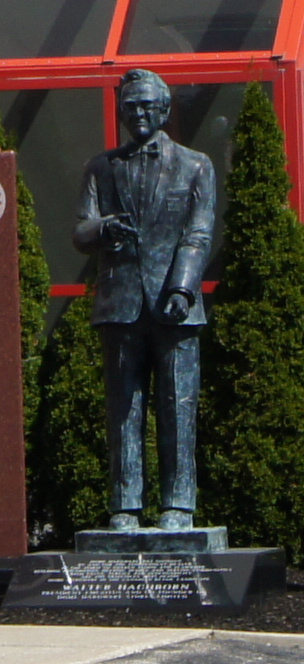
Walter Hachborn, was a Canadian businessman and co-founder, with two others, of Home Hardware, a Canadian home improvement and construction retailer which supplies contractors and individual retail consumers.

Salem is a compact rural community and unincorporated place in the incorporated township of Centre Wellington, Wellington County, in southwestern Ontario, Canada.
Elias Weber Bingeman Snider was an Ontario businessman and political figure. He represented Waterloo North in the Legislative Assembly of Ontario as a Liberal member from 1881 to 1894.
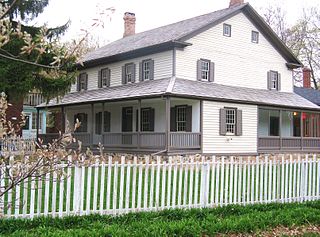
The Schneider Haus National Historic Site, formerly Joseph Schneider Haus, is a museum in Kitchener, Ontario, Canada. Situated on some of the earliest land to be settled by non-Indigenous peoples in what would become Waterloo County, the museum includes the oldest remaining dwelling in the area and was named a National Historic Site of Canada in 1999.

Conestogo is a community in the Canadian province of Ontario, located in the township of Woolwich in Waterloo Region. The population in 2016 was 1,270.

Floradale is an unincorporated rural community in Southwestern Ontario, Canada. It is part of the township of Woolwich in the Regional Municipality of Waterloo. The community is located 5 kilometres to the north of the town of Elmira, Ontario and 20 kilometres to the north of the city of Waterloo, Ontario. Canagagigue Creek, a tributary of the Grand River, flows through the village. The community is located in an area where there is an historically large settlement of Old Order Mennonites noted for their traditional customs, dress, and use of horse and buggies.
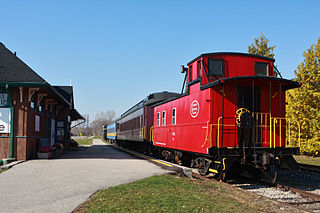
The Waterloo Central Railway (WCR) is a non-profit heritage railway owned and operated by the Southern Ontario Locomotive Restoration Society (SOLRS). In May 2007, SOLRS received joint approval from the Region of Waterloo and the City of Waterloo to run trains from Waterloo to St. Jacobs and potentially as far north as Elmira. On a typical operating day, the train runs three times a day on Tuesdays, Thursdays and Saturdays. In 2015, the railway lost regular running rights south of Northfield Drive to make way for the Ion light rail project. All Market Train service now runs between St. Jacobs Farmers' Market, the Village of St. Jacobs, and Elmira, Ontario.
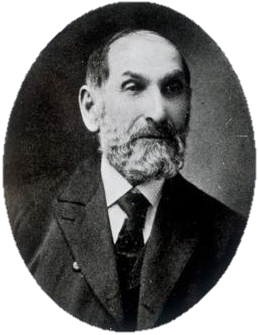
Jacob Yost Shantz was a Mennonite farmer, businessman, and industrialist from Ontario, Canada. He played a significant role in the urban development of Berlin, Ontario, where he held a succession of civic roles over a period of almost three decades, culminating in a term as mayor in 1882. Over the span of his life, Berlin was transformed from a rural agricultural settlement known as Ebytown into a bustling manufacturing centre; this was a change mirrored by Shantz, who began his adult life as a farmer and sawmiller, and ended it as a prominent local industrialist.
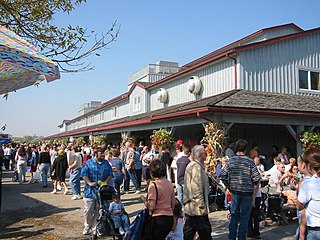
St. Jacobs Farmers' Market is a farmers' market and flea market in Woolwich, Ontario, Canada. It is located to the south of King Street North, to the east of Weber Street North, and to the west of the railway tracks. It is the largest year-round farmer's market in Canada, and is a popular destination for residents of the town and nearby communities, as well as tourists from Canada, the United States, and Europe. It draws about 1 million visitors annually.

The Waterloo Junction Railway (WJR) is a short line railway in the Region of Waterloo, Ontario, Canada. It runs northward from the former Grand Trunk Railway (GTR) North Main Line in downtown Kitchener, through Waterloo and St. Jacobs before terminating in Elmira. It is currently owned by the City of Waterloo and operated by CN as the Waterloo Spur. The Waterloo Central Railway runs tourist trains on the line, and the Ion rapid transit runs on the route for a short distance.

Avetria Networks Inc. is a wholly owned private Canadian corporation. As a regional telecommunications company in the province of Ontario, Avetria provides telecommunications products and services including wireless and fiber internet access, voice, and IPTV television. The company is based in Southwestern Ontario, Maryhill, Ontario; it was originally based in Bloomingdale, Ontario. The company was first formed as a fixed wireless internet provider to provide internet to the communities of Woolwich, Maryhill, Ariss, West Montrose, Winterbourne, Conestogo and North Waterloo. Avetria Networks competes in the fiber to the home sector with Rogers Communications and Bell Canada.






















